
Triteleia lugens, the Coast Range triteleia or dark-mouthed triteleia, is a monocot flowering plant in the genus Triteleia. It is endemic to California, where it is known from the Coast Ranges north and south of the San Francisco Bay Area. Its habitat includes forests and chaparral.
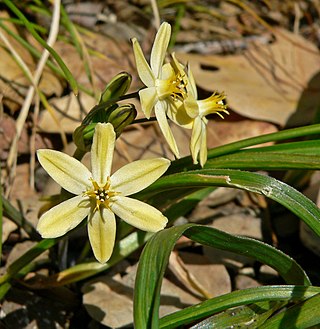
Triteleia ixioides, known as prettyface or golden star, is a monocotyledon flowering plant in the genus Triteleia. It is native to northern and central California and southwestern Oregon, where it can be found in coastal and inland coniferous forests and other habitat. It is a perennial wildflower growing from a corm. It produces one to two basal leaves up to 50 centimeters long by 1.5 wide. The inflorescence arises on an erect stem up to 80 centimeters tall. It is an umbel-like cluster of several flowers each borne on a pedicel up to 7 centimeters long. The flowers are variable in size, measuring one to nearly three centimeters in length. They are pale to bright yellow, or sometimes purple-tinged white. There are six tepals with darker midveins in shades of green, brown, or purple. The lobes are funnel-shaped and may open flat or somewhat reflexed. The six stamens form a fused tube that protrudes from the corolla; they have broad, flat filaments and whitish, yellowish, or blue anthers.

Hooveria purpurea is a species of flowering plant related to the agaves known by the common name purple amole. This species of soap plant is endemic to California, where it grows in the Santa Lucia Range, in the Central Coast region. There are two varieties of this plant, and both are believed to be quite rare. It is a federally listed threatened species.

Erythronium grandiflorum is a North American species of plants in the lily family. It is known by several common names, including yellow avalanche lily, glacier lily, and dogtooth fawn lily. The Ktunaxa name for glacier lily is maxa.
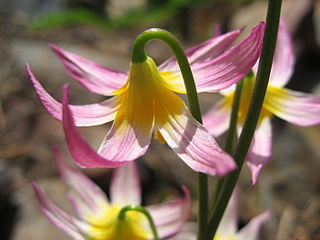
Erythronium purpurascens is a species of flowering plant in the lily family which is known by the common names purple fawn lily and Sierra Nevada fawn lily.
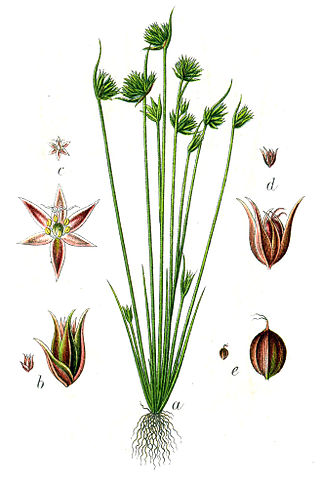
Juncus capitatus is a species of rush known by the common names dwarf rush and leafybract dwarf rush. It is native to Europe, Asia and North Africa. It is also an introduced species in parts of North America such as California and the Gulf Coast. It grows in moist areas, such as wet sand, vernal pools, and ditches.

Allium tuolumnense is a rare species of wild onion, known by the common name Rawhide Hill onion.

Allium praecox is a species of wild onion known by the common name early onion.
Brodiaea insignis is a rare species of flowering plant in the cluster-lily genus known by the common name Kaweah brodiaea. It is endemic to the Sierra Nevada foothills of central Tulare County, California, where it grows along the Tule and Kaweah Rivers. It is considered endangered on the state level.
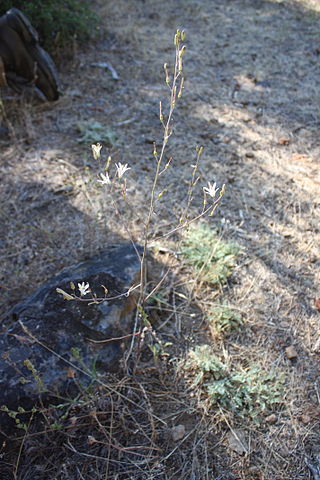
Chlorogalum angustifolium is a species of flowering plant, known by the common name narrowleaf soap plant.

Prosartes hookeri is a North American species of flowering plants in the lily family known by the common names drops of gold and Hooker's fairy bells.

Erythronium pusaterii is a species of flowering plant in the lily family known by the common names Kaweah Lakes fawn lily and Hocket Lakes fawn lily.

Lilium maritimum is a species of lily known by the common name coast lily. It is endemic to California, where it is known only from the coastline north of San Francisco. It formerly occurred south of San Francisco, but these occurrences have all been extirpated. The species is now restricted to the North Coast from Marin County to Del Norte County, and is most common in Mendocino County. It grows in the California coastal prairie habitat, coniferous forests, and bogs amongst Drosera species.

Lilium occidentale is a rare North American species of lily known by the common name western lily. Its species name 'Occidentale' means 'westernmost' and refers to its location along the West Coast. It is native to northwestern California and southwestern Oregon. It grows in coastal prairie habitat, swamps and stagnant bogs with Drosera species, bluffs and sandy cliffs, and seaside spruce forests. This rare wildflower is limited in distribution and directly endangered by a number of environmental factors. It is a federally listed endangered species and it is listed as endangered by the states of California and Oregon.
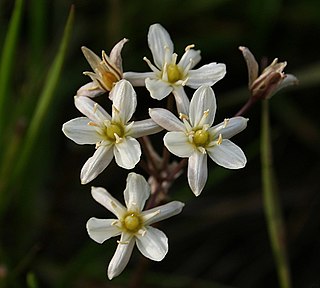
Muilla maritima is a species of flowering plant known by the common names sea muilla and common muilla. It is native to California and Baja California, where it grows in many types of habitats from the coast to the Mojave Desert and Sierra Nevada foothills and other inland mountains, in grassland, woodland, desert, and forest floras. It is a perennial plant growing from a corm and producing an erect flowering stem up to half a meter tall. The onion-like leaves at the base of the stem may be 60 centimeters long. The flowering stem bears an umbel-shaped array of many flowers on pedicels up to 5 centimeters long. Each flower has six tepals which are green-tinged white in color with brownish midribs and no more than 6 millimeters in length. At the center of the flower are six erect stamens with blue, green, or purplish anthers.

Muilla transmontana is a species of flowering plant known by the common name Inland muilla. It is native to sections of the Great Basin in Nevada and in California east of the major mountain ranges. It grows in mountain forest and scrubby high desert and plateau habitat.

Triteleia montana is a monocot flowering plant in the genus Triteleia. Its common names include Sierra triteleia, and mountain triteleia. It is endemic to California, where it is limited to the Sierra Nevada. It occurs in coniferous forests on granite soils. The Latin specific epithet montana refers to mountains or coming from mountains. It is a perennial wildflower growing from a corm. There are two or three basal leaves measuring up to 30 centimeters long and just a few millimeters wide. The inflorescence arises on an erect, rough-haired stem up to 25 or 30 centimeters tall. It is an umbel-like cluster of several flowers each borne on a pedicel up to 3 centimeters long. The flower is yellow with a dark midvein, and dries purplish. The funnel-shaped corolla is made up of six tepals up to a centimeter long each. There are six stamens with white or blue anthers.
Toxicoscordion brevibracteatum is a species of flowering plant known by the common name desert deathcamas. It is native to Baja California, Sonora, and California, where it grows in sandy desert habitat among creosote and Joshua trees.

Toxicoscordion paniculatum is a species of flowering plant known by the common names foothill deathcamas, panicled death-camas, and sand-corn. It is widely distributed across much of the western United States, especially in the mountains and deserts of the Great Basin region west of the Rocky Mountains. It grows in many types of habitat, including sagebrush plateau, grasslands, forests, and woodlands, etc.
Erythronium elegans is a rare species of flowering plant in the lily family known by the common names Coast Range fawnlily and elegant fawnlily. It is endemic to Oregon in the United States, where it is known from about 12 occurrences in the northern Coast Range.


















